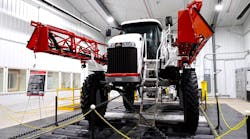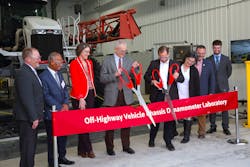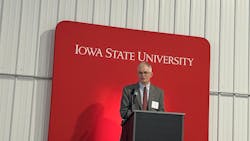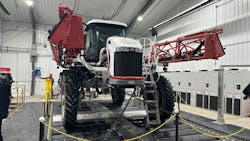New Iowa State Dynamometer Lab to Benefit Heavy Equipment Development
Iowa State University recently completed building an Off-Highway Vehicle Chassis Dynamometer Laboratory (Dyno Lab) at its BioCentury Research Farm located between Ames and Boone, IA. The facility allows for controlled, dynamic testing of heavy-duty mobile equipment such as construction and agricultural machinery.
Danfoss Power Solutions donated $1.8 million for the building of the Dyno Lab as well as provided technical support for its development. The company has a facility in Ames, which includes one of its three Application Development Centers (ADC), and has partnered with the university on a variety of projects over the past 45 years.
READ MORE: Danfoss Development Center to Boost Vehicle Testing and Design
By supporting this project, Danfoss is helping not only with the training of future engineers but also gaining an additional testing resource as the Dyno Lab will be available for use by manufacturers of various types.
A ribbon cutting ceremony was held November 17, 2022, for the new Dyno Lab, marking its availability for use by the university and industry partners.
A State-of-the-Art Test Lab
The new Dyno Lab is administered by Iowa State University’s Department of Agricultural and Biosystems Engineering (ISU ABE). It features a state-of-the-art dynamometer capable of testing the power control and transmission systems of large machinery, and is the only one of its kind at a public institution in the U.S.
Off-highway equipment featuring tracks or tires can be tested on the dynamometer. Vehicles can be tested up to 450 kW (600 hp) per corner at speeds of up to 80 km/h (50 mph), enabling a range of small to large size machinery to be evaluated. Independent monitoring and loading of the traction system at each vehicle corner is possible, benefiting a variety of testing projects.
Tests which can be conducted at the Dyno Lab include:
- Drawbar power
- Dynamic braking
- Hill cresting
- Fuel-to-wheel energy efficiency and more.
With the various tests possible, Iowa State and industry partners can better evaluate overall performance and efficiency of a vehicle as well as component and control system interactions. Use of the dynamometer will enable the collection of accurate, repeatable data which may not be possible with outdoor testing.
“We are excited to see how the new dynamometer fosters breakthroughs in off-highway vehicle technology,” said Jeff Herrin, senior vice president of research and development, Danfoss Power Solutions, in the company’s press release announcing the completion of the Dyno Lab. “Comprehensive testing can reduce design cycles and speed up research and development, enabling us and our customers to implement industry-leading solutions at a faster rate.”
More Data Brings Better Performance Evaluation
Machines ranging from 50-600 hp can be tested at the new Dyno Lab. The dynamometer is designed so that each of the four corners of a vehicle can be independently controlled and tested. One corner could be in a motoring state while another in absorption, allowing for a range of testing and data to be gained.
This is achieved through the use of four independently controlled regenerative AC dynamometers. The dynamometers can absorb power from vehicles during the testing process and put it back onto the electrical grid. Or during a motoring state energy can be put back into the vehicle system through the wheels, helping to reduce overall energy use throughout the testing process.
A PTO and a hydraulics dynamometer are available at the lab as well, providing further testing capabilities.
Brian Steward, Professor, Department of Agricultural and Biosystems Engineering at Iowa State, said in an interview with Power & Motion at the ribbon cutting for the Dyno Lab that the dynamometer was built to be flexible. Six large rollers enable testing of tracked machines while wheeled equipment can be lowered and cradled in the well of the dynamometer. The dynamometer can be adjusted to accommodate wheelbases from 60-170 in.
The dynamometer has been up and running for about a month (at the time of publishing) and Steward said five different machine types have been tested on it so far and it has proven to be a highly capable piece of testing equipment.
Steward said it is exciting to see the amount of data that can be collected. “For those of us who are researchers, once you have data, then you can think of all sorts of possibilities of what you can do,” he said. “We couldn't collect that data in this sort of control environment before.”
During initial tests, university researchers found they could test machinery to its maximum capacity. With the amount of testing and data possible at the new lab, researchers and industry partners can start to get a better understanding of what is happening to an entire machine, not just the components within it. This will enable the ability to understand how certain performance issues may arise and how to fix them or how to go about further improving efficiency.
“We face a situation where the efficiency of these [heavy equipment] platforms is very important,” said Steward. “There are so many innovations happening right now that provide opportunities for testing. And we're right at the center of that.”
The Value of Testing Accessibility
Having the new Dyno Lab at Iowa State helps to put the university at the forefront of agricultural machinery innovation, said Steward. Agriculture is an important industry for feeding the global population, and like other industries trends such as electrification and automation are bringing about technological changes to the equipment used in this industry. Having the ability to conduct various tests on an array of agricultural and other heavy machinery will help to advance these machines and the work they do.
Dave Wohlsdorf, Senior Director, Sales and Innovation Operations at Danfoss Power Solutions said during the ribbon cutting ceremony that it was an easy decision for the company to support the creation of the Dyno Lab. He noted Danfoss intends to use the facility to complement the field testing it does at its ADC in Ames.
In addition to the tests possible with the dynamometer, Wohlsdorf said Danfoss expects “testing will include some unique tests such as independent loading and monitoring of each wheel on a vehicle. This will allow us to fully understand the overall vehicle performance…and will help us reduce the time required to design and develop new solutions, which in turn enables Danfoss and our customers to design better performing vehicles and get them to market faster.”
Besides aiding industry, and possibly most importantly, the new laboratory facility will benefit the engineering students at Iowa State by providing them testing and validation skills which may be necessary for their future employment.
READ MORE: How do We Shape the Future Workforce?
“All of us at Danfoss are excited about the possibilities this new laboratory provides to educate future engineers,” said Wohlsdorf. Danfoss hires many students from Iowa State as interns each year, and has several alum working at the company. The new laboratory will equip students with even more hands-on experience they can bring to their future careers.
“We look forward to continuing to work closely together [with Iowa State] to expand utilization of this laboratory to many equipment manufacturers…from all across North America. And together we'll utilize this capability to foster innovation in off-highway vehicle technology,” concluded Wohlsdorf.







